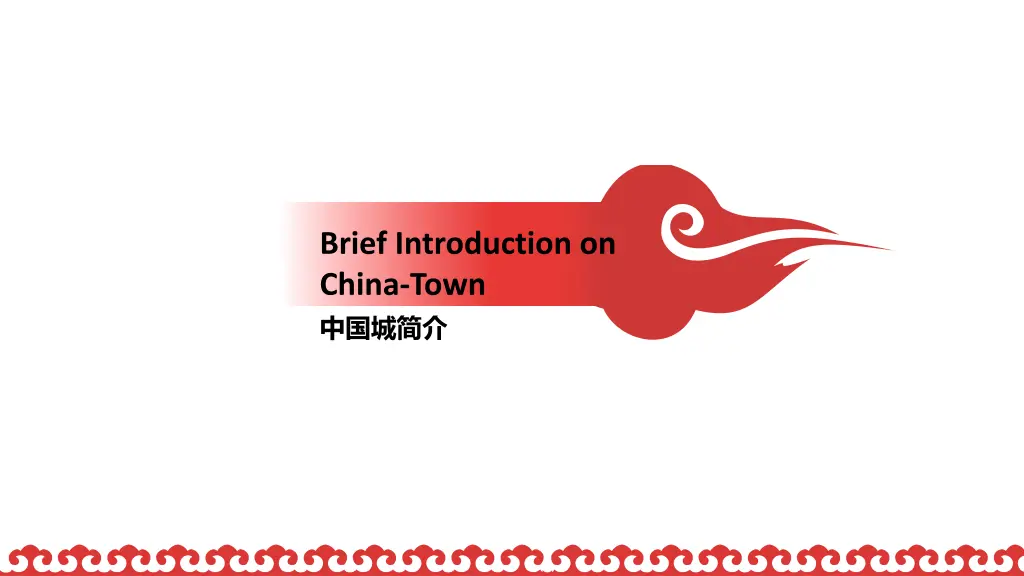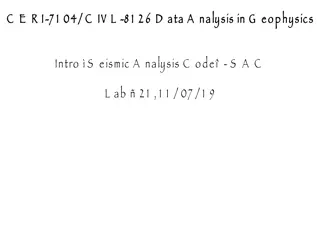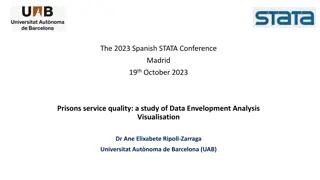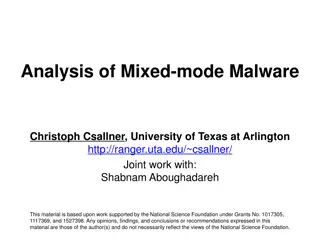
Exploring the Fascinating World of Chinatowns
Discover the origins, culture, and impact of Chinatowns worldwide, from the first recorded enclave in Manila to the bustling communities in Manhattan. Learn about the Chinese diaspora and the unique characteristics of these vibrant micro-nations contributing to global diversity.
Download Presentation

Please find below an Image/Link to download the presentation.
The content on the website is provided AS IS for your information and personal use only. It may not be sold, licensed, or shared on other websites without obtaining consent from the author. If you encounter any issues during the download, it is possible that the publisher has removed the file from their server.
You are allowed to download the files provided on this website for personal or commercial use, subject to the condition that they are used lawfully. All files are the property of their respective owners.
The content on the website is provided AS IS for your information and personal use only. It may not be sold, licensed, or shared on other websites without obtaining consent from the author.
E N D
Presentation Transcript
Brief Introduction on China-Town
The origin of Chinatowns China-town is an ethnic enclave of the Chinese community living outside of mainland China (including Hong-Kong and Taiwan). The first recorded China-town was established in the year 1594 in at Binondo, Manila (Philippines). The Chinatowns are formed as a result of migration of Chinese community to other countries due to many number of reasons such as like labor, new culture (liberty from socialist economy), including religious----- ---- causes expanding their business etc. and Great --- ---- leap forward and other famines. (most number----- -------------during Mao Zedong)
Pic of oldest China-town Binondo, Manila Binondo, also Known as Pinyin in Chinese is the first ever (oldest) Chinatown established by the Chinese in Manila, Philippines in the year 1594 for Catholic Chinese. In modern times business thrives in this region in old fashioned Filipino-Chinese style.
China Towns- in Gist A Micronation It is a community of Chinese people (85%) including Tibetan, Korean nationals alongside with Chinese. They stay in a closed community with local ties to sustain in their day to day lives. Today many China-Towns across the world exists each with unique and absent elements. They contribute towards the host nation economy at a smaller scale which cannot be felt. Also the host country usually does not support these type of people. In short a Chinatown is a diaspora micronation which has its own rules and regulations including a working economy.
50 million Chinese Diaspora of the World (2019) South Africa South America Thailand Oceania Region The Region of Australia, New Zealand and other surrounding combined hold 2.5 million Chinese North America 9 million islands Asia is home to 15 Million with Thailand At 10 million Holds 5 million The region of south Africa and surrounding countries hold nearly 7 lakhs Chinese www.presentationgo.com
Lets have a peek at some famous Chinatowns around the world
China-Town in Manhattan Manhattan, NY The Chinatown in lower Manhattan, New-York houses the denser Chinese populated with around 1 lakh people. They live in a close community. Predominantly it is filled with Cantonese. It is one of the ten densely populated Chinese community in the western world.
Chinatown in San Francisco CT in San Francisco This Chinatown covers 24 square blocks and houses the second biggest Chinese community outside Asia (New York's is first). There are exotic emporia, temples, restaurants, Chinese banks, schools, law offices, bookstores, laundries and factories recalling the sweatshops of earlier times. tea houses,
Chinatown in Bangkok Chinatown in Bangkok Chinatown in Bangkok, Thailand has been hugely influential in the peoples life since the beginning of the city. It is the center of the gold trade and has a 200-year-old market, Taoist temples, and a 5-ton solid-gold Buddha at Wat Traimit.
Chinatown in London, UK Chinatown in London Gerrard Street, which lies between Leicester Square and Old Compton Street, is the main thoroughfare of London's Chinatown. Chinese immigrants, mainly Cantonese from Hong Kong, started to settle in the area during the 1950s. Street names are subtitled in Chinese, and the tops of telephone boxes resemble mini pagodas.
Chinatown in Singapore Chinatown in Singapore Although Singapore is predominantly filled with Chinese, Raffles' original town plan, which assigned the different races to various districts. Here the Chinatown filled with old style Chinese shops and frogs to be skinned in the fresh produce market.
Chinatown in Paris Chinatown in Paris Paris's Chinatown is bordered by Avenue d'Italie and Avenue d'Ivry. The area is a mini- city of skyscrapers and streets lined with Thai groceries, Vietnamese Chinese tearooms. Chinatown's gift shops are a treasure trove of gaudy decorations, trinkets and figurines, alongside elegant rice bowls, fine teas and tea sets, and good-quality Chinese dresses. noodle bars and
Chinatown in Melbourne Chinatown in Melbourne Cantonese-speaking arrived in Melbourne in great numbers during the 1850s, hopeful of making fortunes in the colony they described as "New Gold Mountain. They established an area where they could eat, gamble and smoke opium with their fellow countrymen on Little Bourke Street. Aside from food, there are also several bars in here that are packed cheek by jowl on weekends. Chinese immigrants
China-Town in India A brief Analysis
- Chinese In India-Analysis Migrants/1st gen Chindians Chinese Diaspora in India Prisoners(histori cal reference) Expatriates
Chinese Diaspora in India- (Chindians) Mumbai The Chinese population here decreases at a higher rate. The only Chinese community can be found at areas nearby Kwan Kung temple, Mazagaon, Mumbai. (4000 Chinese stay) New Delhi There is no Chinatown here in new Delhi. Statistics show that only Chinese workers on contracts for 2- 3 years stay here in New Delhi. There are no fixed Chinese community. Kolkata The original Chinatown in India is located here. Nearly for more than 5 centuries pure Chinese bloodline exists in Calcutta. We can see that in detail later slides. (nearly 5000 peoples live here) Tamil Nadu/Chennai- Historical ref Although, no Chinatowns here. Chinese culture exists here way back from British India period. A escaped community today stays in parts of Nilgiris hills. Expatriates are there in Chennai. www.presentationgo.com
Chinatown in Kolkata Tiretta Bazzar Situated in Central Kolkata, Hakka Chinese stay here. Once a enclave of 20,000 Chinese today it is only home to 7000 Chinese peoples. They engage themselves in tanning and food industry. Today so called the Indian Chinese cuisine was born here at Bengal which is now famous in many other parts of India. They also engage in licensed opium trading for quick cash. There is also a school and local Chinese = newspaper.
Chinatown Economy Underground Economy Normal Economy Also known as blood economy (illegal activities), it type is predominantly active in the eastern part of the world, especially in the Chinatowns Of Thailand, Burma, and Predominantly located on western nations, this heavily rely upon tourism, that is they sell of their Chinese culture to these people. This includes their art, pottery, cuisine, and other Chinese goods and services and they make hefty revenue from it. ($700 million) Malaysia.
List of Authentic foods The Original C ny n The authentic Chinese food is not like as we see in the social media today. It is much more than that and very expensive in nature. The cuisine is one of the worlds delicious cuisine which includes BBQ stingrays, roast pork, pork rib soup, noodles & dumplings, nasi cockles and eggs, puffer fish meat (quite expensive). In my opinion these authentic Chinese foods must be tired at least once in our lifetime. ($700 million industry)
Blood Economy of CT Prostitution/Brothels Or what is commonly called as red light areas has become a main stream business in parts of Chinatowns in Thailand, Malaysia, Italy. This is a billion dollar industry and runs alongside with the opium dens. Tong This organisation particularly remain in smokes and shadows. They smuggle illegal immigrants and sell off or either loot a big amount from them to make them escape the authorities. Triad (organized crime) Opium Dens The Chinese are godfathers in the opium business. Every Chinatown has house structure called den which has plenty of opium's in different smokable formats. Triads is a organised crime syndicates that is spread across the Chinese diaspora of the world. Especially active in the region of Thailand, Hong Kong, India, and Malaysia.
Brief Analysis on Triads Triads is a common word for the Chinese crime syndicates that functions across worlds Chinese community. (same syndicates work under different names in diff region). Some famous triads include 14K, Shui Fong, Luen Group, Wo Hop To, Bamboo Union, Ping On. Etc. These triads can be broadly classified into two categories. One is the Dark forces (loosely based groups) and the other is Black Societies (more organised and deadly). The first influence local markets and second one able to establish routes for illegal trading across countries. They engage in criminal activities like Drug trafficking , Health care fraud, Counterfeiting, State sponsored terrorism, Virtual Cyber gangs, Unethical businesses and much more. Thus they spread their activities internationally and able to establish their Chinese diaspora for generations. They are one the biggest challenges faced by internal security forces.
Organizational Structure of Triads Incense master Recruiting members Vanguard Operations officer 49 ers Thugs/members Deputy Mountain Red Pole master Region enforcer Operational head on a select region Mountain Master The Official Head Deputy Mountain master Regional head Triad Founder (unknown)/Real head Red Pole Regional enforcer Blue Lanterns local boss members White paper 49 ers Straw Sandal Liaison Officer fan Thugs/Members Administrator
Brief Analysis-Opium Dens The Chinese are the godfathers on opium trading. Opium smoking is part of their culture and they established in other parts of the world through Chinatowns. They established opium dens (smoking rooms/houses) in a traditional Chinese style which is attached behind in a typical Chinatown restaurant. The room is equipped with the opium in different smokable forms along with necessary accessories like opium pipes, oil lamps, liquor, trappings and (including) female attendants. All of this opium is brought safely into the Chinatowns by the black forces of a triads. They have well established route maps and dealers. (400$ million). In this image you can see the typical opium den and the Chinese men smoking evil poppy (pure opium) with female attendants.
Brief Analysis on Brothels Background of workers What happens inside Ignoring the licensed one, the illegal brothels offer temporary marriage, Hiring women (sexually) for parties, selling of workers many usually customers abuse them to their own imagination. The workers are usually kidnapped illegal immigrants and from poor families of Chinese, Tibetan, Mongolian, Japanese and Korean including minors, Men and Women. (Even humans raised only for these works exists) Organizational Structure of the prostitutes Locations (usually disguised) All the brothels are under the guise of massage and health treatment centers, beauty spa, bathhouses, saunas, hotels with inbuilt opium dens, and street crawlers in and around Chinatowns. The customers also range from locals to foreign tourists. 7 tier prostitute is the usual structure. That is each tier varies in services offered and the prostitutes are categorised into each according to their (purchased) cost, beauty, ethnic and other terms. For example 2nd tier is called packaged wife, 3rd three halls, 4th dingdong girls, 5th called hairdressing salon sisters, 6th tier is street girls..
THANK YOU PRESENTED BY ANIRUDH






















